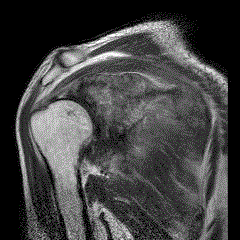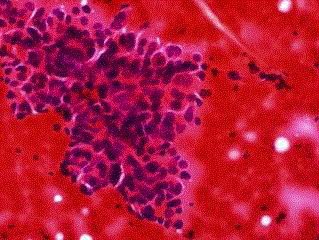Case Report
Prostate Adenocarcinoma Presenting with Giant Shoulder Mass in a Young Man
Fatos Dilan Koseoglu1*, Omercan Topaloglu2, Emel Ebru Pala3 and Cagatay Arslan4
1Department of Internal Medicine-Division of Hematology, Ege University, Turkey
2Department of Internal Medicine-Division of Endocrinology, Inonu University, Turkey
3Department of Pathology, Tepecik Education and Research Hospital, Turkey
4Department of Medical Oncology, Izmir MedicalPark Hospital, Turkey
*Corresponding author: Fatos Dilan Koseoglu, Department of Internal Medicine-Division of Hematology, Ege University, Erzene Mahallesi, Gençlik Caddesi, 35040 Bornova/İzmir, Turkey
Published: 07 Sep, 2017
Cite this article as: Koseoglu FD, Topaloglu O, Pala EE,
Arslan C. Prostate Adenocarcinoma
Presenting with Giant Shoulder Mass
in a Young Man. Ann Clin Case Rep.
2017; 2: 1433.
Abstract
The rising incidence across all ages made prostate cancer the most commonly diagnosed noncutaneous cancer in men. As a result of increase in PSA screening worldwide, detection of prostate cancer in younger patients becomes more often. Metastatic disease is associated with poor prognosis especially in younger patients. Unusual presentations should not mislead clinicians and refrain from omitting prostate cancer as the most frequent cancer in men. Timely treating with chemo- and hormonal therapy will contribute to patients’ survival time and quality of life. Here in we report a young man who presented with a giant shoulder mass mimicking sarcoma which was concluded as prostate adenocarcinoma.
Keywords: Prostate adenocarcinoma; Sarcoma; Shoulder mass
Introduction
Prostate cancer is among the most common cancers in men worldwide, with an estimated 1,600,000 cases and 366,000 deaths annually and most commonly diagnosed non-cutaneous cancer in men across all ages [1]. Prostate cancer tends to grow so slowly that most men die of other causes before the disease becomes clinically advanced. As indicated in autopsy series, where prostate cancer is detected in approximately 30 percent of men age 55 and approximately 60 percent of men by age 80, prostate cancer do not become clinically evident [2]. Early-onset prostate cancer that is prostate cancer diagnosed at age ≤55 years is rare with a rate of 10% [3]. Although the median age of prostate cancer diagnosis has shifted toward younger ages, decreasing from 72 years in 1986 to 67 years in 2009 as a result of screening serum prostate specific antigen (PSA) levels [4]. Prostate cancer in young men tends to behave more aggressive than men diagnosed at an older age. On the other hand those diagnosed at a young age have less comorbidity as well and disease unrelated death rates are lower in younger metastatic prostate cancer patients compared to older counterparts [5]. The five-year relative survival is 100 percent in patients with localized prostate cancer but 29.3 percent among those diagnosed with distant metastases [6]. Here, we report a young man who was diagnosed prostate adenocarcinoma presented with a giant shoulder mass mimicking sarcoma.
Case Presentation
A 49-year old man was admitted with a right shoulder mass and pain occurred 4 months ago. Physical examination revealed the painful mass, restricting the locomotion of right shoulder. A magnetic resonance imaging showed a destructing right scapular mass with soft tissue invasion (Figure 1). Fine needle aspiration biopsy revealed malignant cytology consistent with metastatic adenocarcinoma (Figure 2). The PSA level was 300 ng/ml. 18-FDG PET-CT revealed pathologic activity at vertebral column and hypermetabolic masses in prostate gland, paraaortic region and right shoulder. The patient was diagnosed as ‘metastatic prostate cancer’. Radiotherapy was given to right shoulder mass and thoracal 7-8. vertebrae. Antihormonal treatment with goserelin, bicalutamide and zoledronic acid were begun. Bicalutamide was stopped after 1 month of treatment. Pain on the shoulder regressed and MRI showed shrinked shoulder mass in a 6 months manner. The control level of PSA reduced to 0,35 ng/ml. After 10 months of treatment bone pain increased, bone scintigraphy, chest and abdominal computerized tomography scans and right shoulder MRI showed disease progression at bones however PSA was 1.1 ng/ml and total testosteron was < 20 ng/dl. There was no response to bicalutamide re-treatment and patient was accepted as castrate resistant. Docetaxel and prednisone was begun and gosereline and zoledronic acid was continued. He had stable disease at the end of 10th cycle of docetaxel and chomtherapy was stopped after 10 cycle. Gosereline and zoledronic acid were continued. Disease progression occurred at bones and lungs after 11 months from the last chmotherapy. Cabazitaxel treatment with primary prophylaxis of filgrastim was begun for metastatic castrate resistant prostate cancer beyond progression after docetaxel chmotherapy. He received 3 cycles of cabazitaxel after progression but was lost due to neutropenic fever afetr the 3rd cycle of cabazitaxel. The patient lived 30 months from the diagnosis of prostate cancer.
Figure 1
Figure 2
Figure 2
Fine needle aspiration biopsy showed malignant epithelial cells
with hyperchromatic, pleomorphic nuclei and high nuclear-cytoplasmic ratio
(HE, x40).
Discussion
In this report, we presented a case of metastatic prostate
adenocarcinoma presenting with a giant soulder mass mimicking
sarcoma. This patient lived 30 months from the diagnosis of metastatic
prostate carcinoma with a lower survival duration compared to older
metastatic prostate cancer patients. This patient was treated with
the evidence based treatment options with current data in related
dates between 2011 and 2014. However literature data on metastatic
prostate changes rapidly in last 3 years.
For the male patients presenting a metastatic mass, serum PSA
level and the ratio of free PSA/total PSA should be determined; if
necessary, immunohistochemical (IHC) staining for PSA and P504S
should be done from the metastatic mass [7]. It is recommended that
older than 40 years old men with an adenocarcinoma or carcinoma not otherwise specified, should undergo a PSA test. Especially
male patients presenting with bone metastases or multiple sites of
involvement should have PSA levels assessed regardless of age [8].
The PSA value contributes significantly to the diagnosis of prostate
cancer. As in our case, for the patients with bone metastases and
palpable tumors in addition to the high levels of PSA (>100 ng/
ml), prostate gland biopsy is not necessary for the diagnosis.
18-fluorodeoxy glucose PET scan is not recommended for protate
cancer staging. However it might help to discriminate extra-prostatic
tumors. It might also have value in metastatic prostatic cancers with
high proliferation index. In 2013, hormonal manuplation was present
for the definition of castrate resistant prostate cancer. But in 2014
it was removed from EAU guideline and other guidelines due to
entrance of new antiandrogen and androgen biosynthesis inhibitor
treatments into clinical practice.
After 2015; our practice has changed in newly diagnosed
metastatic prostate cancer especially in patient with high volume
disease. This practice changing data have come from CHAARTED
and STAMPEDE tiral results; respectively [9,10]. Docetaxel was
shifted to earlier phase of metastatic prostate cancer which was
endocrine treatment naïve with 6 cycles of treatment and with or
without oral prednisone addition. And now in year 2017 abireterone
showed a similar efficacy in newly diagnosed, hormonal treatment
naïve metastatic prostate cancer patients with a high quality of life
data with LATITUDE trial results [11]. Trials testing new generation
antiandrogens are on the way for newly diagnosed endocrine
treatment naïve metastatic prostate cancer [12,13].
Metastatic prostate adenocarcinoma is often responsive to
hormone therapy; namely androgen deprivation treatment for past
days and new androgen biosynthesis inhibitor abireterone recently
and highly probably new generation antiandrogens for near future.
However old friend; docetaxel contributed to survival rates of newly
diagnosed metastatic prostate cancer patients’ for last 2 years.
Conclusion
Unusual presentations of metastatic prostate carcinoma should not mislead clinicians. Metastatic prostate adenocarcinoma might be with poor prognosis in younger patients. Evidence of treatment options for metastatic prostate cancer is changing rapidly.
Authors’ Contributions
FDK: Conception and design, interpretation, manuscript writing,
critical revision and final approval of the manuscript.
CA: Conception and design, interpretation, manuscript writing.
OT: Manuscript writing.
EEP: Achieve and interpret the figures.
References
- Global Burden of Disease Cancer Collaboration, Fitzmaurice C, Allen C, Barber RM, Barregard L, Bhutta ZA, et al. Global, Regional, and National Cancer Incidence, Mortality, Years of Life Lost, Years Lived With Disability, and Disability-Adjusted Life-years for 32 Cancer Groups, 1990 to 2015: A Systematic Analysis for the Global Burden of Disease Study. JAMA Oncol. 2017; 3: 524-548.
- Bell KJ, Del Mar C, Wright G, Dickinson J, Glasziou P. Prevalence of incidental prostate cancer: A systematic review of autopsy studies. Int J Cancer. 2015;137: 1749-1757.
- Siegel R, Naishadham D, Jemal A. Cancer statistics, 2012. CA Cancer J Clin. 2012; 62: 10–29.
- Howlader NNA, Krapcho M, Neyman N, Aminou R, Altekruse SF, Kosary CL, Ruhl J, Tatalovich Z, Cho H, Mariotto A, Eisner MP, Lewis DR, Chen HS, Feuer EJ, Cronin KA, editors. SEER Cancer Statistics Review, 1975–2009. 2012 (Vintage 2009 Populations). 2012
- Salinas CA, Tsodikov A, Ishak-Howard M, Cooney KA. Prostate cancer in young men: an important clinical entity. Nat Rev Urol. 2014; 11: 317-323.
- Ries LAG, Melbert D, Krapcho M, et al (Eds). SEER Cancer Statistics Review, 1975-2004. National Cancer Institute. 2007.
- Sheridan T, Herawi M, Epstein JI, Illei PB. The role of P501S and PSA in the diagnosis of metastatic adenocarcinoma of the prostate. Am J Surg Pathol. 2007; 31: 1351-1355.
- NCCN Guidelines Version 1.2013-Occult Primary. Immunohistochemistry Markers for Unknown Primary Cancers (OCC-A).MS-8
- Scott E. Chemohormonal therapy in metastatic hormone-sensitive prostate cancer. Sweeney CJ, Chen YH, Carducci M, Liu G, Jarrard DF, Eisenberger M, Wong YN, Hahn N, Kohli M, Cooney MM, Dreicer R, Vogelzang NJ, Picus J, Shevrin D, Hussain M, Garcia JA, DiPaola RS. Department of Medicine; Department of Biostatistics and Computational Biology; Dana-Farber Cancer Institute, Boston; Harvard Medical School, Boston; Johns Hopkins University, Baltimore; University of Wisconsin Carbone Cancer Center; School of Medicine and Public Health; Madison; Fox Chase Cancer Center, Temple University Health System, Philadelphia; Indiana University Melvin and Bren Simon Cancer Center, Indianapolis; Mayo Clinic, Rochester, MN; University Hospitals Case Medical Center, Seidman Cancer Center; Cleveland Clinic Taussig Cancer Institute; Both in Cleveland; University of Virginia Cancer Center, Charlottesville; Comprehensive Cancer Centers of Nevada, Las Vegas; Siteman Cancer Center, Washington University School of Medicine, St. Louis; NorthShore University Health System, Evanston, IL; University of Michigan Comprehensive Cancer Center, Ann Arbor; Rutgers Cancer Institute of New Jersey, New Brunswick. N Engl J Med. 2015; 373: 737-746. [Epub 2015 Aug 5]. doi: 10.1056/NEJMoa1503747. Urol Oncol. 2017; 35: 123.
- James ND, Spears MR, Clarke NW, Dearnaley DP, De Bono JS, Gale J, Hetherington J. Survival with Newly Diagnosed Metastatic Prostate Cancer in the "Docetaxel Era": Data from 917 Patients in the Control Arm of the STAMPEDE Trial (MRC PR08, CRUK/06/019). Eur Urol. 2015; 67: 1028-1038.
- Fizazi K, Tran N, Fein LE, Matsubara N, Antolín AR, Alekseev BY et al. LATITUDE: A phase III, double-blind, randomized trial of androgen deprivation therapy with abiraterone acetate plus prednisone or placebos in newly diagnosed high-risk metastatic hormone-naive prostate cancer. J Clin Oncol. 2017; 35.
- Beer TM, Armstrong AJ, Rathkopf DE, Loriot Y, Sternberg CN, Higano CS, et al. Enzalutamide in metastatic prostate cancer before chemotherapy. N Engl J Med. 2014; 371: 424-433.
- Chi KN, Chowdhury S, Radziszewski P, Lebret T, Ozguroglu M, Sternberg C, Sims RB, Yu M, Naini V et al. TITAN: A randomized, double-blind, placebo-controlled, phase 3 trial of apalutamide (ARN-509) plus androgen deprivation therapy (ADT) in metastatic hormone-sensitive prostate cancer (mHSPC). Ann Oncol (2016) 27 (suppl_6): 771TiP


